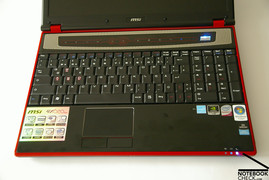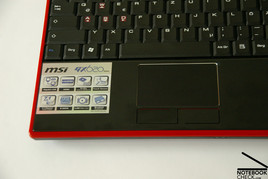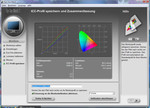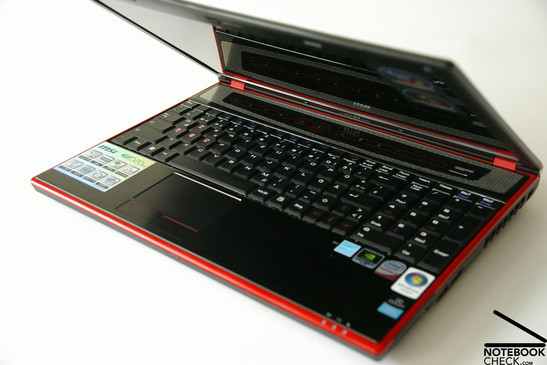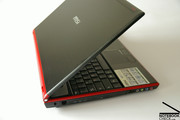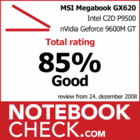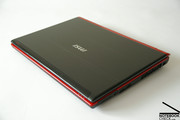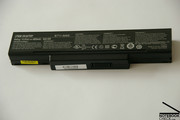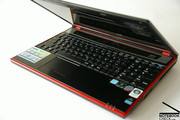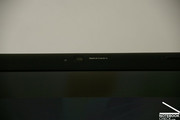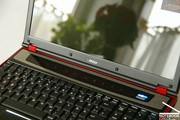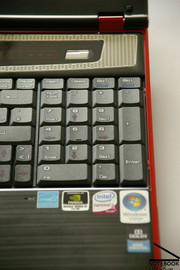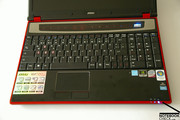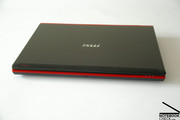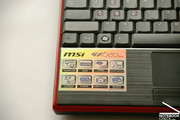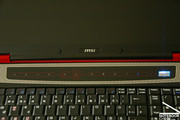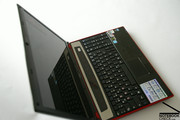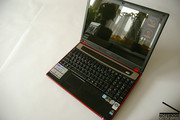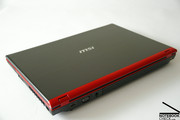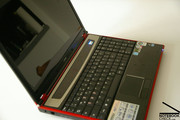Review MSI Megabook GX620 Notebook
MSI on the Fast Lane.
It hasn't been all too long ago that we tested the Megabook GX60 from the renowned manufacturer Micro-Star International, better known under their abbreviation MSI. (Review Megabook GX600). MSI has used the time and worked on a successor model. Doing this, the manufacturer not only refurbished the built in hardware but also gave the whole notebook a new design, or rather a new case. We had the opportunity to put the successor model, the MSI Megabook GX620-9543VHP, through its paces.
The manufacturer MSI didn't confine themselves on only refreshing the "old" GX600 model but overhauled, adjacent to updating the hardware, the complete design of the notebook. Now the GX620-9543VHP model has an Intel Core 2 Duo P9500 Penryn processor with a 2.5 GHz pulse rate, an nVIDIA Geforce 9600M GT with an applied 512 MB memory, which can borrow further 768 MB from the RAM, if necessary. This combination is assisted from a total of 4 GB DDR2-800 RAM from Transcend. A 320 GB hard disk from Western Digital is used for the mass storage. The whole thing looks very promising on paper. How this system operates in applications and how qualified the MSI Megabook GX620-9543VHP notebook is for gaming, we will find out shortly.
Note: The MSI Megabook GX620 is also available as the model 8443VHP as well as the 7345VHP, whereas these models are equipped with a weaker processor than our test notebook which is the GX620-9543VHP version. Therefore all values and measurements correlate to this model and don't necessarily apply to the other models.
Case
Whereas the case of the Megabook GX620 forerunner was still built with a plastic housing in a black high gloss look, the manufacturer MSI reassessed its views and gave this a tough and high-quality magnesium/aluminum case. With this, a shortcoming of the forerunner has been improved and weighs, despite the aluminum case, only 2.7 kilograms, still being light-weighted for a notebook in the 15 inch range. Besides that, the case turned out fairly flat.
Adjacent to the change from plastic to aluminum, the design has been completely modified. The case is still black, but has an accentuating crimson strip on the four sides. The two quite small hinges, responsible for poising the display, are also kept in red. Besides the multimedia keys lit in blue and the silver grid-like covering for the loudspeakers in the area between the keyboard and the display, the rest of the rough notebook surface is kept in a plain but elegant black.
Thanks to the aluminum case the GX620 is very resistant against selective compression and only gives away slightly at a very strong use of force. The notebook even put away the handling of the test device and lifting it on one side. Regarding the workmanship, the notebook barely leaves any place for critique from us. All edges of the GX620 have been evenly rounded so that no sharp edges could be found. The same applies to the corners. The only point of critique here is the area of the multimedia keys which surface isn't made out of aluminum and therefore can't keep up with the rest of the case concerning resistance. The function/multimedia keys give in quite obviously at too strong pressure.
What the closure concerns, the manufacturer MSI does without the standard closure mechanisms and builds on magnetism for the Megabook GX620. Therefore, the display is kept closed magnetically during transportation. Unfortunately, fingerprints are rather easily seen despite the rough surface, making it necessary to clean the areas concerned frequently.
Connectivity
With regards to the offered connections in the GX620 there is not much to belittle. The elaborate offer reaches from standard ports like USB 2.0, Firewire and VGA-out up to modern interfaces such as HDMI or eSATA ports.
The connections of the GX620 are concentrated mainly on the right and left side and on the back of the notebook. Therefore the front side is kept clear of the various connections.
Built in on the left side are the Kensington lock, a LAN socket and the optical drive followed from USB 2.0 port and four audio ports with which a 7.1 system can be accessed to, as well.
The right side has a 4in1 card reader for SD/MMC/MS/MS Pro, an Express Card Slot 54 and a Firewire port. Not far beside these are two additional USB ports, of which one can be used as an eSATA port. Furthermore the fan shaft and the modem port can be found here, too.
The HDMI port finds its place on the back side. One or two centimeters further to the right are the VGA-out socket and the connection for the power converter. Otherwise the backside is occupied from the rather elongated battery.
The pretty smart and compact distribution of the connections could convince us in the test. Since the front side is kept clear, typing and working on the notebook is very pleasant because there isn't a disagreeable cable tangle and the ejecting DVD tray of the optical drive is spared.
The Megabook GX620 has various options to choose from for communicating with other computers or the internet. Among others, a LAN (Realteck RTL8168B/8111B Family PCI-E Gigabit Ethernet NIC) as well as a WLAN connection (Intel(R) Wireless WiFi Link 5100) and a Bluetooth module is on board, too.
As meanwhile almost standard, the GX620 has an integrated webcam placed in the center of the upper area of the display frame. The integrated microphone of the MSI Megabook GX620 is not found in the display frame, but rather on the wrist supports slightly under the keyboard on the right side.
Input Devices
As for the keyboard, the GX620 offers a separate numeric block, too, which goes to expense of the rest of the keyboard. The manufacturer really has used every square millimeter of the keyboard, which one can easily see at first sight. The arrow keys are therefore quite small, just like the return and shift keys on the right side, whose extremely petite key and position are odd and could lead to problems by some users.
Just as strange and still known from the forerunner, is the Fn key which is exactly there where the control key is usually found. This is fact can sometimes be unhandy especially for gamers. In order to lift gaming ambitions the WSAD keys are highlighted in color.
A further flaw of the keyboard is that it gives away quite easily and bends through somewhat.
The touchpad of the Megabook GX620 is set a bit to the left and can be described as precise and exact. The two mouse keys, which seemed bit stiff to us, do their job quite well, too.
Display
The Megabook GX620 has a 15.4 inch WXGA LC display making a maximal resolution of 1280x800 pixels possible. The manufacturer MSI equipped the GX620 with a glossy display, just like it's currently customary in many other notebooks, generally not being a problem as long as the display brightness is high enough and one refrains from outdoor use.
With this, we come to the biggest weakness of our test device. The display brightness with a maximal value of 157.2 cd/m2 measured in the upper right corner turned out rather low, followed from only 151.4 cd/m2 in the upper center area. For indoor use this might be sufficient but one has to watch out that it's not too light because the Glare display can be used as a mirror in radiant surroundings. Therefore the GX620 is not suitable for outdoor use.
| |||||||||||||||||||||||||
Brightness Distribution: 84 %
Contrast: ∞:1 (Black: 0 cd/m²)
Apart from that, the offered image quality is rather good. The Megabook GX620 presents saturated and powerful colors, the displayed images are sharp and we couldn't observe schlieren formations at any time. Fast games like Crysis, Hellgate London or World in Conflict didn't prove to be a problem for the screen and looked (as far as the performance allowed) beautiful and smooth.
In respect to viewing angle stability one can be quite satisfied. The possible viewing angles turned out to be generous in the vertical as well as in the horizontal area.
Performance
The MSI Megabook GX620 has been equipped with an Intel Core 2 processor of the Penryn generation, the P9500 with 2.5 GHz. Furthermore the notebook has a total of 4 GB DDR2 RAM from the manufacturer Transcend and an nVidia 9600M GT graphic card with 512 MB VRAM.
The Megabook GX620 has, thanks to the built in hardware and not least again through the turbo button, quite a bit to offer in consideration of performance. The CPU (2.93GHz) and the RAM pulse rate becomes over clocked which, according to MSI, should lead to an increase of performance of up to 20%. Tests were made with PCMark05, Cinebench R10 and the newest offspring from Futuremark, the PCMark Vantage. The test runs were made once without and once with the turbo feature, whereas we wrote the results with activated turbo in brackets "(xxxx)" in order to differentiate both results better.
The Cinebench R10 made the start. The GX620 reached in the single-core rendering an evaluation of 2836 (3300) points. 5286 (6144) points were given to the test candidates in the multi-core test, which is a performance increase of a bit over 16% in both cases. The shaders were evaluated with 3724 (3723) in the Cinebench. Here it becomes obvious that the turbo function doesn't have any influence on the graphic card.
Next, the GX620 has to show how it copes with Futuremarks PCMark05 and PCMark Vantage. The already somewhat moldy PCMark05 awarded 6297 (7358) points for the performance of our test device. Here, as well, an increase of performance of 16% results thanks to the turbo button.
PCMark Vantage gives the Megabook GX620 a total of 3901 (4132) points, equivalent to an increase of approx. 5.9%.
As a mass storage device with a 320GB hard disk (WD3200BEVT-22ZCT) with 5400 rpm from Western Digital is used. That should offer sufficient place and storage for the beginning. Whom this doesn't suffice has the possibility, thanks to the abundant connections - among others also an eSATA, to extend the storage capacity by means of external hard disks.
| PCMark 05 Standard | 7358 points | |
| PCMark Vantage Result | 4132 points | |
Help | ||
| Cinebench R10 | |||
| Settings | Value | ||
| Shading 32Bit | 3724 Points | ||
| Rendering Multiple CPUs 32Bit | 6144 Points | ||
| Rendering Single 32Bit | 3300 Points | ||
Gaming Performance
What does it look like in gaming appliance? In the application area the GX620 could get a good 16% more performance with help from the turbo feature. If this is possible in gaming, we will find out soon.
First we'll have a look at the 3DMark Benchmarks results. The already dated 3DMark01 run came up with 30009 (34297) points, slightly more than 14% of performance increase. In the 3DMark06 and the 3DMark05 test it reached a score or 17028 (17184) and 10969 (11120) (performance increase in 3DMark03: 0.9%; in 3DMark05: 1.4%). The turbo mode couldn't append to the previous performance thrust even in the 3DMark06 at a resolution of 1280x800. The GX620 reached a total of 5887 (6002) points, whereas the CPU alone received a value of 2334 (2712) with an activated turbo. This means a total increase or 1.9%. If one only looks at the evaluation of the CPU, it is a performance increase of 16%.
The points or respectively the performance increase through the turbo doesn't look very different in the 3D Vantage. The GX620 received a total of 1704 (1719) points (0.8%). The GPU alone was rewarded with 1400 (1392) points in the 3DMark Vantage and the CPU 4898 (5817) points.
Converting this, it equals a performance increase of 18.7% for the CPU.
In the gaming test we used, as usual, the resource hungry Crysis, also Hellgate: London, World in Conflict and the rather old classic Doom 3.
Doom 3 was playable as smooth as silk in all detail settings, which wasn't surprising. There were still 188.4 (206.7) frames per second possible even in the ultra setting.
The already more prevailing game World in Conflict didn't provide all too many problems for the Megabook GX620, if played under DX9. Our test candidate averagely reached a resolution of 41 (42) frames set in the native resolution of 1280x800 in the integrated benchmark test, which is fully adequate for a smooth gaming pleasure. Unfortunately, with DX10 the whole thing looks different. It's only smoothly playable with 29 (31) fps in a resolution of 800x600 pixels.
Hellgate: London delivers a quite similar picture. Under DX9 one achieves with AA and high details with the native resolution 30- 35 fps in the outer areas. The inner levels are presented with an average of 62 fps. That changes abruptly as soon as one sets DX9 to DX10. Outer areas are unplayable with only 10 frames per second, despite deactivated AA.
The hit game Crysis was tested with a resolution of 1024x768. The integrated benchmark gave the GPU 81.2 (84.3) and the CPU 78 (78) fps, in low settings. The GPU was rewarded with only a slight bit more 30.11 (30.17) and the CPU 30.9 (30.35) frames per second at medium details, which allowed for a still playable experience. At high details the Megabook GX620 has to finally surrender. With a mere 16.12 (16.4) fps for the GPU and 15.1 (15.6) fps for the CPU Crysis is no longer playable under these conditions.
Generally, one can say that the turbo function primarily offers an increase of performance in application programs. The performance increase is very well evident, but unfortunately barely noticeable in gaming because the over-clocking correlates only to the CPU and not to the graphic card. The more of performance is therefore only in the 3DMark benchmark apparent. The one or two frames more are in most cases irrelevant for gaming.
| 3DMark 2001SE Standard | 34297 points | |
| 3DMark 03 Standard | 17184 points | |
| 3DMark 05 Standard | 11120 points | |
| 3DMark 06 1280x800 Score | 6002 points | |
| 3DMark Vantage P Result | 1719 points | |
Help | ||
| Doom 3 | |||
| Resolution | Settings | Value | |
| 1024x768 | Ultra, 0xAA, 0xAF | 206.7 fps | |
| 800x600 | High, 0xAA, 0xAF | 205.7 fps | |
| 640x480 | Medium, 0xAA, 0xAF | 210.4 fps | |
| 640x480 | Low, 0xAA, 0xAF | 213.1 fps | |
| Crysis - CPU Benchmark | |||
| Resolution | Settings | Value | |
| 1024x768 | High, 0xAA, 0xAF | 15.6 fps | |
| 1024x768 | Medium, 0xAA, 0xAF | 30.9 fps | |
| 1024x768 | Low, 0xAA, 0xAF | 78 fps | |
| Crysis - GPU Benchmark | |||
| Resolution | Settings | Value | |
| 1024x768 | High | 16.4 fps | |
| 1024x768 | Medium, 0xAA, 0xAF | 30.17 fps | |
| 1024x768 | Low, 0xAA, 0xAF | 84.3 fps | |
| World in Conflict - Benchmark | |||
| Resolution | Settings | Value | |
| 1024x768 | High, 2xAA, 2xAF | 24 fps | |
| 1280x800 | High, 2xAA, 2xAF | 20 fps | |
| 800x600 | High, 2xAA, 2xAF | 31 fps | |
| 1024x768 | Medium, 0xAA, 0xAF | 49 fps | |
| 1280x800 | Medium, 0xAA, 0xAF | 42 fps | |
| 800x600 | Medium, 0xAA, 0xAF | 59 fps | |
Emissions
System Noise
The system noise that the Megabook GX620 developed under load kept itself within limits and stays very well in bounds of the acceptable. With a maximum of 39.2 dB the test device stayed slightly under the 40 dB border. The fan noise is very audible but is not penetrating or disturbing. According to our measuring instrument a maximum of 34 dB was noted down to a minimal level of slightly over 30 dB (30.2) in the idle mode which is also a rather satisfying value, we think.
Noise level
| Idle |
| 30.2 / 34 / 34 dB(A) |
| Load |
| 38.5 / 39.2 dB(A) |
 | ||
30 dB silent 40 dB(A) audible 50 dB(A) loud |
||
min: | ||
Temperature
The MSI Megabook GX620 generally kept a cool head during the test period. The maximum temperature that we found on the upper side amounted to 32.8 degrees centigrade in the lower right quadrant. A pleasant working or playing on the GX620 is made possible because of this. The measurements on the bottom side of our test candidate left nothing to be desired, either. The highest value was only 37.4 degrees centigrade in the upper left corner, still being within the limit.
(+) The maximum temperature on the upper side is 32.8 °C / 91 F, compared to the average of 36.9 °C / 98 F, ranging from 21.1 to 71 °C for the class Multimedia.
(+) The bottom heats up to a maximum of 37.4 °C / 99 F, compared to the average of 39.2 °C / 103 F
(+) The palmrests and touchpad are reaching skin temperature as a maximum (32.8 °C / 91 F) and are therefore not hot.
(-) The average temperature of the palmrest area of similar devices was 28.7 °C / 83.7 F (-4.1 °C / -7.3 F).
Loudspeakers
The built in loudspeakers correlate rather precisely with our expectations from this price class. The sound of the GX620 doesn't really knock off anyone's socks. Especially the deep tones sound very thin and are quite unsatisfying. Our test device has, however 4 audio sockets which allow connecting a reasonable 7.1 system. Even easier, of course, is using good headphones.
The offered volume of the loudspeakers is more than sufficient for everyday use if one can bare sound quality. Manufacturers like Asus or Toshiba with their Altec Lansing or Harman/Kardon systems have shown that this doesn't have to be the case.
Battery Life
What the battery runtime concerns, we tested this again with the BatteryEater software. The Megabook GX620 could convince us with a good 192 minutes in the endurance test with the readers settings (everything out, max. energy saving mechanisms). In the stress-test with the BatteryEater in classic setting the cell survived 81 minutes before longing for the outlet.
It might become somewhat tight when playing a DVD. The supplied battery easily lasted for a movie with a normal playtime of approx. 130 min. but only with clearly reduced display brightness. With the maximum of display brightness the lights went out already after 108 minutes – a very poor result.
The Megabook GX620 reached a result of approx. 146 minutes while surfing mobile via WLAN. Rather an equally underwhelming result.
| Off / Standby | |
| Idle | |
| Load |
|
Key:
min: | |
Verdict
MSI made an overall good job with the Megabook GX620. Due to the solid workmanship and the stability and also thanks to the aluminum case, the manufacturer can set themselves apart from the mass of 15 inch gaming or multimedia notebooks. Not only that. Also, the turbo feature, the over-clocking by a push of a button, and the magnetic closure are things that one doesn't find very often in this price category on the notebook market.
This, combined with the built in hardware (Intel Core 2 Duo P9500 with 2.5 GHz rate, four GB DDR2 RAM, nVIDIA GeForce 9600M GT with 512 applied VRAM, 320 GB hard disk) and the attractive price of slightly over 1000.00 Euro are definitely going to give the competition a rough time.
But the notebook has its flaws, too. The built in display with its weak display brightness, as well as the slight bending of the keyboard left a bit to be desired. Additionally, the keyboard is jam-packed and important keys, such as the right shift key, literally come to short. Besides that, another quite inconvenient fact is that the Fn key is placed there where the Control key usually is. This was in all probability well-intentioned from the manufacturer MSI, but sometimes less is more on keyboard layouts…
The GX620 can be classified as very powerful thanks to the up-to-date hardware, especially in applications which are confirmed by our benchmarks. Furthermore, the notebook has the possibility to over-clock the built in CPU "on the fly", without having to reboot, with help from the turbo button. This feature brings an extra thrust on computing power in applications – according to our tests partially up to 16%, respectively 18%. However, the more of power barely has any influence on the gaming performance of newer games. The one or two frames per second more don't play a role in most cases, either.
Altogether, one can give the Megabook GX620 a good mark, if one accepts the fact of the somewhat poor display brightness. The offered performance is right, just like the gaming potential, as well as the workmanship and the price. The extensive connectivity barely leaves anything to be desired. Competitors with this arrangement and quality are scarcely found in this price category in which the Megabook GX620 moves.









